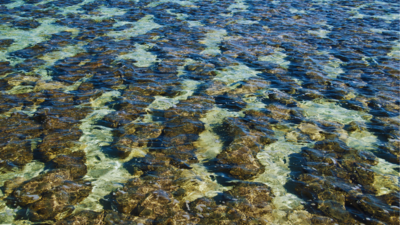ARTICLE AD BOX

Hidden in the remote, icy wilderness of Greenland lies a treasure trove that might just hold the secret to life itself. In one of the discoveries that shook the scientific world, which were 3.7-billion-year-old stromatolite fossils, found in the Isua Greenstone Belt in southwest Greenland, making them the oldest known evidence of life on Earth.
Referring to this, Clark Friend, an independent researcher and co-author of the research said, “Up until now the oldest stromatolites have been from Western Australia and they are roughly 3,500 million (3.5bn) years [old].” He added “What we are doing is pushing the discovery of life earlier in Earth’s history.”Friend further says that the discovery also raises questions about the possibility of life on other planets.Read more: First batch of pilgrims reaches Manasarovar Lake as yatra resumes after 5 years: Chinese Ambassador to India shares photosHowever, some scientists believe that life in the ocean may have started even earlier—and much deeper. Today, vibrant ecosystems exist around hydrothermal vents located near seafloor spreading ridges and subduction zones—regions where Earth’s tectonic plates are either drifting apart or colliding. These ancient rock formations, reportedly, predate even the emergence of oxygen in Earth’s atmosphere, offering a rare glimpse into the planet's primordial past.

So, what exactly are stromatolites?
Stromatolites are layered, rock-like structures formed by colonies of cyanobacteria — some of the earliest and simplest life forms to appear on Earth. These microbial mats trap and bind sediment over time, slowly building up dome-like mounds that harden into fossils. While living stromatolites can still be found in places like Shark Bay in Australia, the Isua fossils are far older, by over a billion years. Discovered in 2016, these Greenlandic stromatolites, reportedly, pushed the timeline of life on Earth back by nearly around 220 million years.
Prior to this, the oldest known microbial fossils were 3.48 billion years old, which were found in Western Australia. But the Isua formations are different. Not only are they significantly older, but they also formed under extreme conditions, supposedly from a time when Earth’s surface was barely solidified.Read more: 7 remarkable natural UNESCO World Heritage Sites that are in India
Why was the discovery significant?
For starters, it challenges long-held beliefs about how life formed after Earth cooled down. It’s estimated that Earth must have formed around 4.5 billion years ago.
The fact that microbial life appeared just 800 million years later suggests that life may have arose relatively quickly under the right conditions, which is a theory that excites astrobiologists studying the potential for life on Mars and exoplanets.
Moreover, these fossils offer clues about the environment in which early life could thrive. Stromatolites like those in Isua formed in shallow marine environments, indicating that early Earth may have had water bodies suitable for life far earlier than expected.
The microbial mats that built these stromatolites were also likely photosynthetic, meaning they might have played a role in gradually oxygenating the planet, which should be a process that took billions of years, but eventually enabled complex life.
Intriguing facts about the Isua stromatolites:
They were almost overlooked: The fossils were initially spotted on a weathered rock surface by Australian geologist Allen Nutman. What seemed like a random rock to others, they actually turned out to be the oldest biological trace on Earth. Formed without oxygen: Unlike modern stromatolites, which rely on oxygen-rich environments, these ancient fossils reportedly grew in an anoxic world. They’re not without controversy: Some scientists argue that the formations might be non-biological in origin, which were created by geological rather than biological processes. However, multiple studies continue to support their biogenic nature.



.png)
.png)
.png)
















 3 hours ago
3
3 hours ago
3









 English (US) ·
English (US) ·